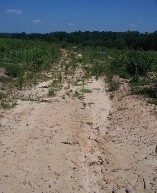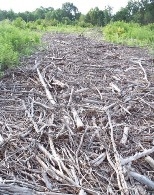Consider Logging Residue Needs for BMP Implementation When Harvesting Biomass for Energy
ID
ANR-108NP
Biomass Harvesting Operations
Utilization of woody biomass for energy has increased substantially in Virginia. While there are a number of definitions for biomass, woody biomass from forest har- vesting operations typically refers to logging residues such as limbs, tops, and other unmerchantable material that would otherwise be left behind on-site after the log- ging operation is complete. Logging residues are typi- cally chipped and then transported to facilities where they are used for fuel. Biomass harvesting in Virginia most commonly occurs on integrated harvesting opera- tions where roundwood and biomass are harvested and utilized at the same time in a single operation.
Implementing Best Management Practices (BMPs) on Forest Harvesting Operations
Considerations for protecting water quality are a critical component of forest harvesting operations. Virginia’s silvicultural water quality law (§10.1-1181.1 through 10.1-1181.7) prohibits excessive sedimentation of streams as a result of silvicultural operations. The Vir- ginia Department of Forestry (VDOF) is responsible for enforcing this law and inspects all logging opera- tions to ensure compliance.

Logging Residues for BMP Implementation
Biomass from logging residues, or “slash,” can be used for energy but can also be used as a BMP for protecting water quality. Slash can be used for stabilizing bare soil areas on temporary roads, skid trails, stream cross- ings, or other areas with disturbed soil. Research has shown that logging slash can be one of the most effec- tive methods for stabilizing bare soil areas and can also be one of the most cost-effective methods. However, if all readily available slash is harvested and used for fuel, then more expensive BMPs may be needed to sta- bilize critical areas and these more expensive options could potentially be less effective than utilizing slash as a BMP.


Bare soil on skid trails (Figure 2) can be a potential source of erosion and sedimentation on logging opera- tions. The photo on the right (Figure 3) shows a skid trail on a biomass harvest site where logging residues were used to stabilize bare soils.
Consider Logging Residue Needs During Harvest Planning
Every harvest site is different and each will have its own unique requirements for implementing BMPs to protect water quality. For sites where there will be substantial work required for BMP implementation, or critical areas such as stream crossings that will need stabilization, harvest planning should evaluate the need for logging residues for BMP implementation. Log- gers and others responsible for harvest planning should evaluate the cost of alternative BMPs for stabilizing bare soil areas and compare that to the potential revenue from utilizing residues for energy. In many cases only a small portion of available logging residues would be needed as a BMP to stabilize critical areas and would often be significantly less expensive than other options for stabilizing those areas. However, after the harvest is completed and available residues have been harvested and transported off site, using residues as a BMP may no longer be an option and other more expensive BMPs may be the only option available.
Increased utilization of biomass for energy has added additional markets for logging businesses but also adds an extra level of complexity to operations. Proper har- vest planning can ensure logging operations are able to take advantage of markets for biomass energy while still meeting requirements to implement BMPs to pro- tect water quality.
For Additional Information on BMP Implementation:
The Virginia Department of Forestry (www.dof.virginia.gov) is responsible for inspecting logging operations in Virginia. All timber harvests are inspected for compliance with the Silvicultural Water Quality Law. The VDOF’s Complete handbook for BMPs for water quality is available online at http://www.dof.virginia.gov/water/index-BMP-Guide.htm .
For specific questions relating to implementation of BMPs on harvest sites, please contact your local VDOF personnel. A list of VDOF personnel can be found online at http://www.dof.virginia.gov/aboutus/contact-us.htm or by calling their central office at 434-977-6555.
This publication was funded, in part, with an integrated, internal competitive grant from Virginia Agriculture Experiment Station, Virginia Cooperative Extension, and the College of Agriculture and Life Sciences at Virginia Tech.
Virginia Cooperative Extension materials are available for public use, reprint, or citation without further permission, provided the use includes credit to the author and to Virginia Cooperative Extension, Virginia Tech, and Virginia State University.
Virginia Cooperative Extension is a partnership of Virginia Tech, Virginia State University, the U.S. Department of Agriculture, and local governments. Its programs and employment are open to all, regardless of age, color, disability, sex (including pregnancy), gender, gender identity, gender expression, genetic information, ethnicity or national origin, political affiliation, race, religion, sexual orientation, or military status, or any other basis protected by law.
Publication Date
December 13, 2019



